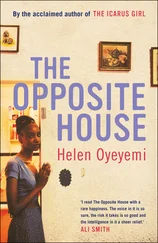Helen Oyeyemi
What Is Not Yours Is Not Yours
open me carefully
— written on an envelope containing a letter from Emily Dickinson to Susan Huntington Gilbert, June 11, 1852
Once upon a time in Catalonia a baby was found in a chapel. This was over at Santa Maria de Montserrat. It was an April morning. And the baby was so wriggly and minuscule that the basket she was found in looked empty at first glance. The child had got lost in a corner of it, but courageously wriggled her way back up to the top fold of the blanket in order to peep out. The monk who found this basket searched desperately for an explanation. His eyes met the wooden eyes of the Virgin of Montserrat, a mother who has held her child on her lap for centuries, a gilded child that doesn’t breathe or grow. In looking upon that great lady the monk received a measure of her unquestioning love and fell to his knees to pray for further guidance, only to find that he’d knelt on a slip of paper that the baby had dislodged with her wriggling. The note read:
You have a Black Madonna here, so you will know how to love this child almost as much as I do. Please call her Montserrat.
Wait for me.
A golden chain was fastened around her neck, and on that chain was a key. As she grew up, the lock of every door and cupboard in the monastery was tested, to no avail. She had to wait. It was both a comfort and a great frustration to Montse, this… what could she call it, a notion, a suggestion, a promise? This promise that somebody was coming back for her. If she’d been a white child the monks of Santa Maria de Montserrat might have given her into the care of a local family, but she was as black as the face and hands of the Virgin they adored. She was given the surname “Fosc,” not just because she was black, but also because her origin was obscure. And the monks set themselves the task of learning all they could about the needs of a child. More often than not they erred on the side of indulgence, and held debates on the matter of whether this extreme degree of fondness was a mortal sin or a venial one. At any rate it was the Benedictine friars who fed and clothed and carried Montse, and went through the horrors of the teething process with her, and rang the chapel bells for hours the day she spoke her first words. Neither as a girl nor as a woman did Montse ever doubt the devotion of her many fathers, and in part it was the certainty of this devotion that saw her through times at school and times down in the city when people looked at her strangely or said insulting things; the words and looks sometimes made her lower her head for a few steps along the street, but never for long. She was a daughter of the Virgin of Montserrat, and she felt instinctively and of course heretically that the Virgin herself was only a symbol of a yet greater sister-mother who was carefree and sorrowful all at once, a goddess who didn’t guide you or shield you but only went with you from place to place and added her tangible presence to your own when required.
When Montse was old enough she took a job at a haberdashery in Les Corts de Sarrià, and worked there until Señora Cabella found her relatives unwilling to take over the family business and the shop closed down. “You’re a hardworking girl, Montse,” Señora Cabella told her, “and I know you’ll make something of yourself if given a chance. You’ve seen that eyesore at the Passeig de Gràcia. The Casa Milà. People call it La Pedrera because it looks like a quarry, just a lot of stones all thrown on top of each other. An honest, reliable girl can find work as a laundress there. Is that work you can do? Very well — go to Señora Molina, the conserje ’s wife. Tell her Emma Cabella sent you. Give her this.” And the woman wrote out a recommendation that made Montse blush to read it.
She reported to Señora Molina at La Pedrera the next morning, and the conserje ’s wife sent her upstairs to Señora Gaeta, who pronounced Montse satisfactory and tied an apron on her. After that it was work, work, work, and weeks turned into months. Montse had to work extra fast to keep Señora Gaeta from noticing that she was washing the Cabella family’s clothes along with those of the residents she’d been assigned. The staff turnover at La Pedrera was rapid; every week there were new girls who joined the ranks without warning, and girls who vanished without giving notice. Señora Gaeta knew every name and face, even when the identical uniforms made it difficult for the girls themselves to remember each other. It was Señora Gaeta who employed the girls and also relieved them of their duties if their efforts weren’t up to scratch. She darted around the attic, flicking the air with her red lacquered fan as she inspected various activities. The residents of Casa Milà called Señora Gaeta a treasure, and the laundry maids liked her because she sometimes joined in when they sang work songs; it seemed that once she had been just like them, for all the damask and cameo rings she wore now. Señora Gaeta was also well liked because it was exciting to hear her talk: She swore the most powerful and unusual oaths they’d ever heard, really unrepeatable stuff, and all in a sweetly quivering voice, like the song of a harp. Her policy was to employ healthy-looking women who seemed unlikely to develop bad backs too quickly. But you can’t guess right all the time. There were girls who aged overnight. Others were unexpectedly lazy. Women who worried about their reputation didn’t last long in the attic laundry either — they sought and found work in more ordinary buildings.
It was generally agreed that this mansion the Milà family had had built in their name was a complete failure. This was mostly the fault of the architect. He had the right materials but clearly he hadn’t known how to make the best use of them. A house of stone and glass and iron should be stark and sober, a watchtower from which a benevolent guard is kept on society. But the white stone of this particular house rippled as if reacting to a hand that had found its most pleasurable point of contact. A notable newspaper critic had described this effect as being that of “a pernicious sensuality.” And as if that wasn’t enough, the entire construction blushed a truly disgraceful peachy-pink at sunset and dawn. Respectable citizens couldn’t help but feel that the house expressed the dispositions of its inhabitants, who must surely be either mad or unceasingly engaged in indecent activities. But Montse thought the house she worked in was beautiful. She stood on a corner of the pavement and looked up, and what she saw clouded her senses. To Montse’s mind La Pedrera was a magnificent place. But then her taste lacked refinement. Her greatest material treasure was an egregiously shiny bit of tin she’d won at a fairground coconut shy; this fact can’t be overlooked.
—
THERE WERE A FEW more cultured types who shared Montse’s admiration of La Pedrera, though — one of them was Señora Lucy, who lived on the second floor and frequently argued with people about whether or not her home was an aesthetic offense. Journalists came to interview the Señora from time to time, and would make some comment about the house as a parting shot on their way out, but Señora Lucy refused to let them have the last word and stood there arguing at the top of her voice. The question of right angles was always being raised: How could Señora Lucy bear to live in a house without a single right angle… not even in the furniture…?
“But really who needs right angles? Who?” Señora Lucy would demand, and she’d slam the courtyard door and run up the stairs laughing.
Читать дальше












